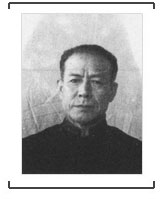据佐佐真之助1954年8月—1956年5月笔供,他1893年出生于日本福冈县。1932年9月到中国参加侵华战争,任关东军第10师团步兵第63联队第3大队少佐大队长,1945年7月任关东军第3方面军第39师中将师团长。1945年8月23日被苏军逮捕。

佐佐真之助
重要罪行有:
1932年10月,“我于佳木斯驻防期间”, “当做密探嫌疑者而逮捕了中国人民约30名”,“其中经拷问后杀害了抗日战士15名,人民6名”。“在佳木斯东北方约10公里之村庄,”“对战场村庄的人民给予了损害,依照我的命令杀害5名”。
1940年8月,在浙江莫干山,“我的部下大队在战斗中曾使用毒瓦斯(绿筒)给予了重庆军(即国民党军——编者注)战士莫大的损害”。10月,在浙江诸暨,“杀害了重庆军战士约600名,在这里边包含战斗中重伤者和被战士杀害的俘虏推测约40名。这个罪恶是我平常教育须杀害这些俘虏的结果。又各大队在战斗中使用毒瓦斯(绿筒),给予了重庆军战士很大的损害”。
1941年1月,在浙江杭州,其指挥的第1大队“逮捕密探嫌疑者约20名,拷问杀害的约7名”;第2大队“逮捕密探嫌疑者约20名,拷问之后杀害的约9名”;第3大队“逮捕密探嫌疑者约25名,拷问杀害的约8名”。
1943年12月,在“荷兰领属东印度安汶岛”,“强制的使用印度尼西亚妇女十数名,设立一个慰安所,供给日本兵士之用,这是对印度尼西亚妇女重大的侮辱行为”。
1944年6月,在从浙江金华向衢州作战中,“杀伤人民约50名”。
1944年12月—1945年5月,在湖北“逮捕了抗日军及抗日团之密探嫌疑者共约90名,在调查拷问之下共杀害约30名”,“于步兵联队宣抚班,也对中国人民进行欺骗的宣传,在其行动中虐待人民,其中杀害约6名”。在湖北当阳,“对奋起正义行动的多数人民,殴打虐待致杀害约20名”。“为了教育刺杀练习试斩等使用,惨杀了俘虏5名”。“师团于湖北省驻防期间,在当阳从以前就设立的日本人经营之慰安所,使之供给日本军队慰安,师团对此经营予以支持。该慰安所里有中国妇女十数名,都是因日本帝国主义之侵略战争,而陷于生活困苦,被强制的收容从事贱业。我想在宜昌、荆门也有和这同样的慰安所。”
1945年1月,在湖北当阳,“杀害了俘虏约5名”。“师团将各部队军官召集到当阳,进行毒瓦斯教育之际,把2名俘虏放入瓦斯室内,为试验毒瓦斯效力使用。又师团军医部,把4名俘虏放入瓦斯室内,进行毒瓦斯效力试验而虐待,终于把他们都杀害了”。
1945年2月,在湖北沙市西北方马山屯“杀害了中国无辜人民约15名”。
1945年3月,在湖北襄樊作战期间,“杀害重庆军战士约3500名(于此之中,包含杀害俘虏若干名)”, “杀害中国人民约200名”,“强奸的中国妇女数字约50名”,“烧毁民房约200户”。“为了隐匿师团之作战企图”,“阻止了3名人民通行,并杀害之外,于其他村庄道路等,逮捕虐待人民,杀害十数名”。“在南漳方面作战中,发现由中国人民4名用担架搬运2名负伤的重庆军战士中,便将该负伤战士2名杀害,并将逃跑的搬运中之人民4名也射杀了”。“各步兵部队于攻击战斗期间,使用毒瓦斯及炮兵发射瓦斯弹,给予重庆军损害”。
另:
1932年9月—12月,“杀害人民:作战时约35名,平常时约8名,计约43名”。
1934年3月—12月,“杀害人民:约10名”。
1936年3月—1937年5月,“杀害人民:约7名”。
1940年3月—1941年3月,“杀害人民:作战时约3名,平常时约24名,计约27名”,“强奸妇女:平常时1名”。
1942年12月—1944年1月,“杀害人民:作战时约3名,平常时约21名(以外负伤约15名),计约24名”,“糟蹋妇女(慰安所):十数名”。
1944年2月—11月,“杀害人民:作战时约50名, “平常时约2名”,“强奸妇女,1名”。
1944年12月—1945年8月,“杀害俘虏:作战时约6名,平常时做刺杀教育用约5名,试验毒瓦斯教育用6名,其它5名,共计约22名”。“杀害人民:“作战时约204名”,“平常时约65名”。“计约269名”。“强奸妇女,作战时约50名(推测数)”, “平常时约17名(包含慰安所)”,“共计约67名””。
According to the written confession of Nosuke Sasaki from August 1954 to May 1956, he was born in 1893 in Fukuoka Prefecture, Japan. In September 1932, he came to China to join the Japanese War of Aggression against China and served as major and battalion chief of the 3rd Brigade of the 63rd Infantry Regiment of the 10th Division of the Kwantung Army. In July 1945, he became lieutenant general and commander of the 39th Division of the 3rd Front Army of the Kwantung Army. On 23 August 1945, he was arrested by the Soviet Army.
Major offences:
October 1932: “during my garrison duty in Jiamusi”, “about 30 Chinese people were arrested as spy suspects”. “Among them, 15 soldiers and 6 civilians were killed after interrogation with torture.” In a village 10 kilometers to the northeast of Jiamusi”, “damage was made to people in the villages on the battlefield and 5 people were killed under my command”;
August 1940: in Moganshan, Zhejiang, “the battalion under my command inflicted great damage to the soldiers of the Chongqing Army (i.e. the Kuomintang Army, note by the editor) by using poison gas (green colored canisters)”. In October in Zhuji, Zhejiang, “about 600 soldiers of Chongqing Army were killed, and among them, 40 had been seriously wounded in combat or taken as captives. This crime was due to my daily instruction that the captives should be killed. All the battalions used poison gas (green colored canisters) in the battles to do great damage to the Chongqing Army soldiers”;
January 1941: in Hangzhou, Zhejiang, the First Battalion under his command “arrested about 20 spy suspects and around 7 of them were killed after interrogation with torture”; the Second Battalion “arrested about 20 spy suspects and around 9 of them were killed after interrogation with torture”; and the Third Battalion “arrested about 25 spy suspects and around 8 of them were killed after interrogation with torture”;
December 1943: in “Ambon Island, Dutch East Indies”, “ forced more than 10 Indonesian women to work in a comfort station to serve Japanese soldiers, which was a gross insult to the Indonesian women”;
June 1944: in the battles from Jinhua to Quzhou, Zhejiang, “killed about 50 people”;
From December 1944 to May 1945: in Hubei, “arrested about 90 spy suspects of the Anti-Japanese Army and anti-Japanese groups, killing about 30 of them through interrogation with torture”, and “in the Propaganda Team of the Infantry Regiment, we made deceptive propaganda for the Chinese people, and maltreated them in practice , killing about 6 people”. In Dangyang, Hubei, “for the majority of the people who rose in a just act against the aggression, about 20 of them were killed through beating and torture”. “To teach Japanese soldiers how to use bayonets and swords, 5 captives were brutally killed”. “When the Division is stationed in Hubei, an existing Japanese-run comfort station in Dangyang was used to serve the Japanese soldiers. The Division supported the operation of this comfort station. There were over ten Chinese women in the comfort station, who were subject to hardship by the war of aggression waged by the Japanese imperialists and forced to come here and work in this humiliating business. I think there were similar comfort stations in Yichang and Jingmen”;
January 1945: in Dangyang, Hubei, “We killed around 5 captives”. “When the Division gathered all the officers in Dangyang and conducted the poison gas training, 2 captives were sent to the gas chamber to test the gas effect. The Medical Department of the Division then put another 4 captives into the gas chamber for the gas effect test. All of them were eventually killed by the poison gas”;
February 1945: “we killed about 15 innocent Chinese people” in Mashantun, to the northwest of Shashi, Hubei;
March 1945: during the battles in Xiangfan, Hubei, “killed about 3,500 soldiers of the Chongqing Army (including some captives)”, “killed about 200 Chinese people”, “raped approximately 50 Chinese women” and “burned down houses of about 200 households”; “In order to conceal the combat intention of the Division”, “stopped 3 people from passing through and killed them, besides, on other village roads, arrested and tortured people, and killed over ten people”; “during the battles in Nanzhang, found 2 wounded soldiers of the Chongqing Army carried on stretchers by 4 Chinese people, then killed the two wounded soldiers and shot dead the 4 men when they tried to escape”; “during the battles, all infantry forces used poison gas and the artillery launched gas shells to cause damage to the Chongqing Army”;
In addition:
From September to December 1932: “killing people: approximately 35 people in battles and 8 in normal times, totaling about 43”;
From March 1934 to December 1934: “killing people: about 10 people”;
From March 1936 to May 1937: “killing people: about 7 people”;
From March 1940 to March 1941: “killing people: about 3 people in battles and 24 in normal times, totaling about 27”; “raping women: one woman in normal times”;
From December 1942 to January 1944: “killing people: approximately 3 in battles and 21 in normal times (wounding about 15 in addition), totaling about 24”; “abused women (comfort station): more than 10 women”;
From February to November 1944: “killing people: approximately 50 in battles; 2 in normal times”; “raping women: one woman”;
From December 1944 to August 1945: “killing captives: approximately 6 in battles, about 5 in normal times for bayonet teaching, 6 for poison gas training and 5 for other purposes, totaling about 22”; “killing people: approximately 204 in battles” and “65 in normal times”, “totaling about 269”; “raping women: about 50 (estimated figure) in battles” and “17 in normal times (including comfort station)”, “totaling about 67”.